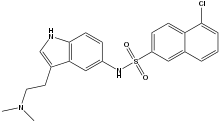E-6837
E-6837 is an orally active, 5-HT6 agonist developed in an attempt to create an anti-obesity medication. In cell lines expressing rat 5-HT6 receptors, it acted as a partial agonist (on presumed silent receptors), while it acted as a full agonist on human 5-HT6 receptors (which are constitutively active). Oral administration of E-6837 reduced food intake, but only transiently. In rats, twice daily administration of E-6837 over the course of 4 weeks resulted in a 15.7% reduction in body weight, compared to 11% reduction for sibutramine. This weight loss remained significant for E-6837 after a 43-day withdrawal period, whereas the weight difference was non-significant for sibutramine (i.e., sibutramine had a rebound effect while E-6837 did not), and this weight loss was found to be due to a loss of fat mass. The reduction in fat mass in E-6837 treated animals was associated with a 50% decrease in plasma leptin levels, and also reduced glucose and insulin levels in plasma after a glucose tolerance test. This indicates that weight loss from E-6837 is associated with improved insulin sensitivity, and thus, better glycemic control.[1][2][3]
 | |
| Names | |
|---|---|
| IUPAC name
5-chloro-N-(3-(2-(dimethylamino)ethyl)-1H-indol-5-yl)naphthalene-2-sulfonamide | |
| Identifiers | |
3D model (JSmol) |
|
| ChemSpider | |
| MeSH | C500059 |
PubChem CID |
|
InChI
| |
SMILES
| |
| Properties | |
Chemical formula |
C22H22ClN3O2S |
| Molar mass | 427.95 g/mol |
Except where otherwise noted, data are given for materials in their standard state (at 25 °C [77 °F], 100 kPa). | |
| Infobox references | |
One proposed mechanism of action is that E-6837 acts on neurons in the hypothalamus, which has shown significant levels of 5-HT6 receptor mRNA. The hypothalamus is one key structure involved in regulating food intake.[1]
See also
References
- Fisas, Angels (August 2006). "Chronic 5-HT6 receptor modulation by E-6837 induces hypophagia and sustained weight loss in diet-induced obese rats". British Journal of Pharmacology. 148 (7): 973–983. doi:10.1038/sj.bjp.0706807. PMC 1751931. PMID 16783408.
- Kirkpatrick, Peter (1 August 2006). "Anti-obesity drugs: Fighting fat". Nature Reviews Drug Discovery. 5 (8): 634–634. doi:10.1038/nrd2123.
- Garfield, A. S.; Heisler, L. K. (24 November 2008). "Pharmacological targeting of the serotonergic system for the treatment of obesity". The Journal of Physiology. 587 (1): 49–60. doi:10.1113/jphysiol.2008.164152. PMC 2670022. PMID 19029184.